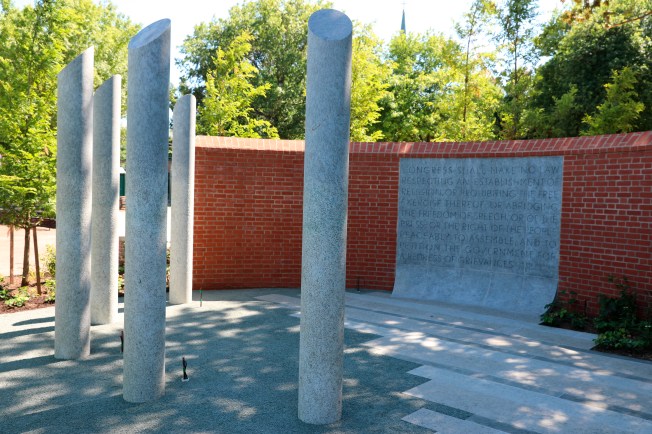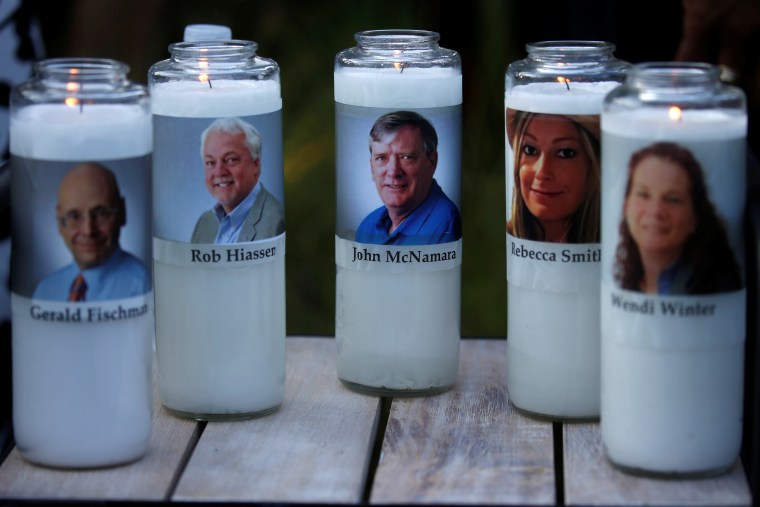In a county courthouse in Annapolis, Maryland, a scaled model of the old Capital Gazette newsroom was perched at an angle on a table toward the jury. One by one, four reporters, a photojournalist, and an advertising sales representative, approached the model to show where they were sitting when a loud noise — some thought it was a broken platter, a firework, or an electrical short circuit —interrupted their quiet workday and they fled for cover, realizing it was a gunman who wielded a 12-gauge Mossberg shotgun.
In the span of a few minutes on June 28, 2018, Jarrod Ramos, who had a vendetta against the paper after it published an article about how he pled guilty to a harassment charge, turned Annapolis, a 40,000-person town best known for its coastal views and as the home of the U.S. Naval Academy, into the site of the worst newsroom shooting in U.S. history. He killed five members of the Capital Gazette staff: editorial page editor Gerald Fischman, editor and columnist Rob Hiaasen, sports writer John McNamara, community correspondent Wendi Winters, and sales assistant Rebecca Smith.
Today, after two weeks of deliberations, the jury found Ramos criminally responsible for his actions, meaning that he will be sentenced to life in prison. Ramos pled guilty to first degree murder and other charges in October 2019; in the recent trial his lawyers argued that he was mentally ill and should be committed to a mental hospital and not prison.
Every year, the Committee to Protect Journalists documents impunity in journalist murders around the world—this is not one of those cases. As today’s ruling shows, the legal process, which so frequently does not come to fruition in other countries, worked. The question lingers, however, of what justice for the attack really means.
Following the announcement of the shooter’s guilty plea, the Capital Gazette editorial board published a piece on October 28, 2019: “There is no justice for the dead. We hope it helps the living.” The board wondered if the trial would lighten the emotional burden that has weighed upon Annapolis ever since. “Perhaps justice will make this violent loss easier to bear for those who lost colleagues, friends and family. Maybe it will be easier for Annapolis,” they wrote. “We have our doubts.”
The trial, which CPJ attended on July 9, brought home how deeply the community has been affected by the murders of the Capital Gazette staffers. During the jury selection process, the judge summoned 300 potential jurors, rather than the typical 100 or fewer. Given how close knit the community is, the judge was concerned that most locals knew about, and had formed an opinion on, the shooting.
The morning the six Capital Gazette staffers testified on July 9, the judge read out a note a juror sent him requesting that they wouldn’t have to watch more of the disturbing footage of the murders, which the defense had shown as part of its arguments that Ramos was not mentally stable. The judge reminded members of the jury that it is their civic duty to hear out all sides of the argument.
At the end of their testimonies, the staffers described their exit from the Capital Gazette office, lined up, hands on shoulders of the person in front of them, past the shattered glass in the entry way. One reporter who was barefoot was picked up by a police officer so she wouldn’t cut her feet.
During the testimonies, journalists in a press box – including me — sat watching the projector screen showing a live recording of the courtroom events, taking notes on how their colleagues were hunted down by the shooter. Journalists were instructed not to speak or interact with witnesses in the trial.
The old Capital Gazette office is now closed. Reporters were, for a while, working out of a new office space that had heightened security including bulletproof walls. In August 2020, the Tribune Company, which owns the Capital Gazette, announced that the paper, which traces its history back to a publishing company that formed in 1727, will no longer have offices in Annapolis and that reporters would work from home or the office of the Baltimore Sun.
The announcement of the newsroom closure spurred Capital Gazette staffers to protest in September 2020; the paper’s publisher locked staff out of their offices ahead of the rally.

Today, a newly erected memorial stands near the city’s waterfront off of Compromise Street. The Guardians of the First Amendment features five columns meant to represent the five Capital Gazette employees who lost their lives. A brass carving of the Capital Gazette paper that the staff defiantly published the day after the shooting hangs on a freshly laid, curved brick wall.
On the day of CPJ’s visit to Annapolis, July 9, the front page of the Capital Gazette featured the names and pictures of Fischman, Hiaasen, McNamara, Smith, and Winters along with the phrase “We Remember June 28, 2018.” Their faces have appeared in the paper every day since.
[Reported from Annapolis, Maryland]
